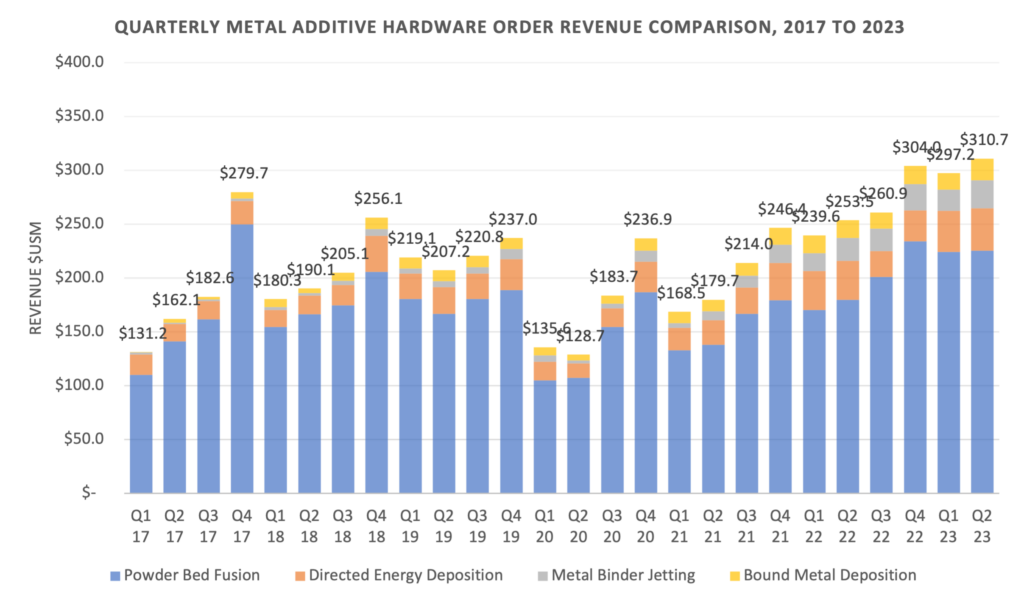SmarTech Analysis has entered a new era as the rebranded Additive Manufacturing Research (AMR). With a new name comes a new feature for 3DPrint.com: the Chart of the Week. Every week, 3DPrint.com readers will be offered a glimpse into the world of additive manufacturing (AM) broken down by the numbers in the form of a chart based on AMR’s research.
This week, AMR’s chart illustrates a comparison of quarterly metal additive hardware order revenue spanning from 2017 to 2023, broken down by powder bed fusion (PBF), directed energy deposition (DED), metal binder jetting (MBJ), and bound metal deposition (BMD). From a holistic view, the industry’s revenue from metal additive hardware orders has seen a consistent rise over the period. Specifically, PBF technology stands out as the dominant player in terms of revenue throughout the years. Starting at $131.2 million in Q1 2017, it has witnessed a steady increase, peaking at $310.7 million by Q2 2023. This should come as no surprise, as PBF is the most widely adopted metal 3D printing technology in the sector.
DED, on the other hand, saw a more fluctuating pattern in revenue but remained a secondary contributor, also unsurprising as it is the second most mature. With occasional peaks and dips, such as the notable rise to $237 million in Q3 2019 followed by a drop to $135.6 million in Q3 2020, it emphasizes the dynamic nature of market demand for this particular technology.
MBJ and BMD have relatively smaller shares of the revenue, to be expected given their comparatively novelty to the industry. However, it’s worth noting that both technologies have experienced growth over the period. Because MBJ, in particular, is being pushed as a method for mass production, we can expect this segment to expand more quickly than the other processes, with BMD as a sort of complementary technology that will grow alongside MBJ. After all, it was recently announced that Apple would be exploring MBJ for the production of its smartwatches. For this reason, MBJ is estimated to grow at a rate of 40.25 percent across the 6.5 years in the graph, while BMD will increase at a compound annual growth rate of 53.06 percent.
Subscribe to Our Email Newsletter
Stay up-to-date on all the latest news from the 3D printing industry and receive information and offers from third party vendors.
You May Also Like
Precision at the Microscale: UK Researchers Advance Medical Devices with BMF’s 3D Printing Tech
University of Nottingham researchers are using Boston Micro Fabrication‘s (BMF) 3D printing technology to develop medical devices that improve compatibility with human tissue. Funded by a UK grant, this project...
GaeaStar and Verve Coffee Roasters Start Pilot Production of Sustainable 3D Printed Coffee Cups
Following a 2022 debut in Germany, GaeaStar, a startup based in San Francisco and Berlin, has begun US pilot production of its sustainable, disposable clay cups and bowls made with...
Meltio and Accufacture Unveil Robotic Metal 3D Printer Made in the US
Meltio has partnered with Michigan-based robotics firm Accufacture to introduce Alchemist 1, a robotic cell designed for wire-laser metal 3D printing made in the US. This new system represents a...
WASP Highlights Advances in Healthcare 3D Printing at Italy’s Exposanità 2024
WASP takes center stage at Italy’s leading healthcare expo, Exposanità 2024, demonstrating the transformative impact of its advanced 3D printing technologies on the medical sector. Known for its line of...

































